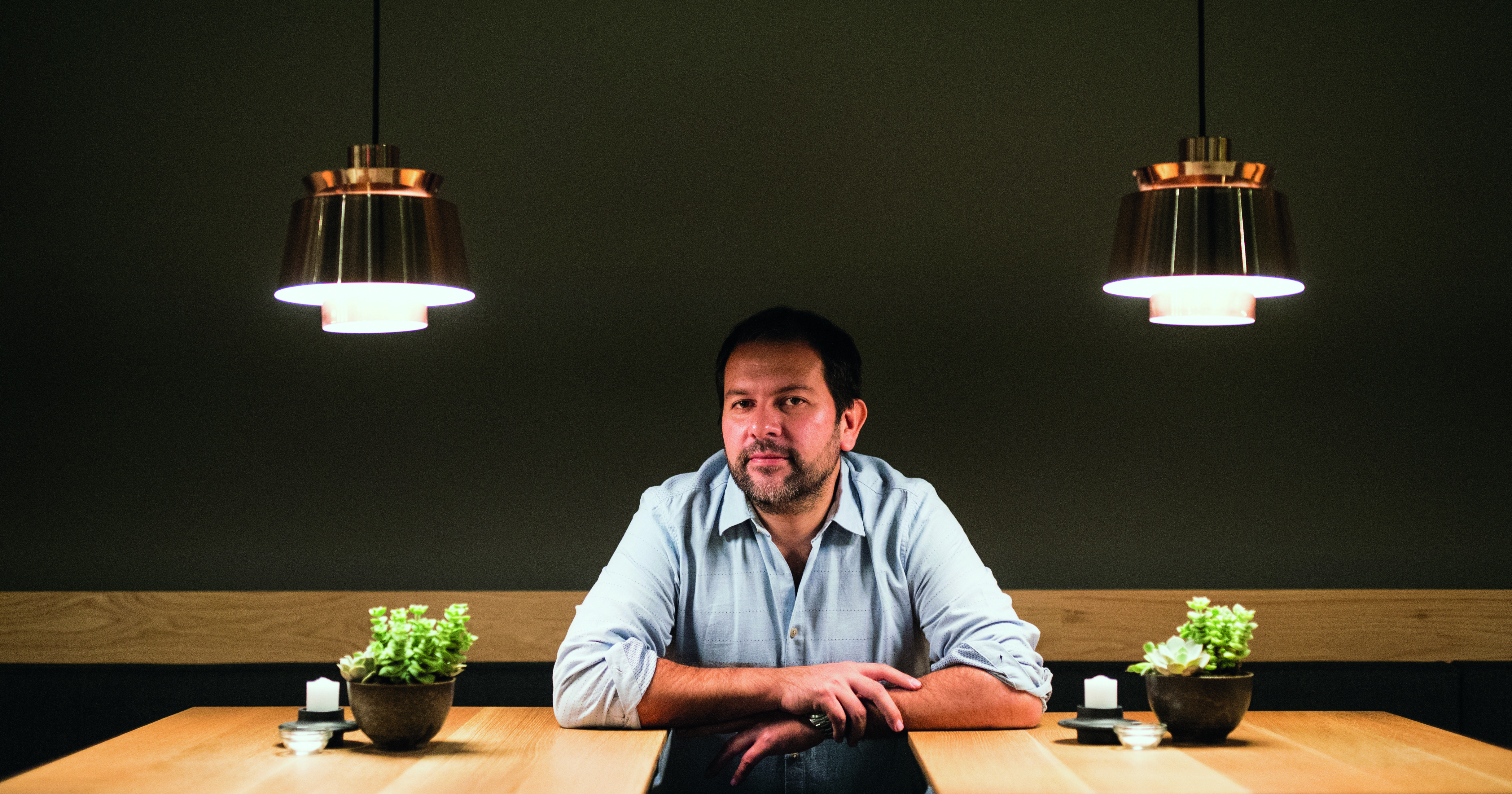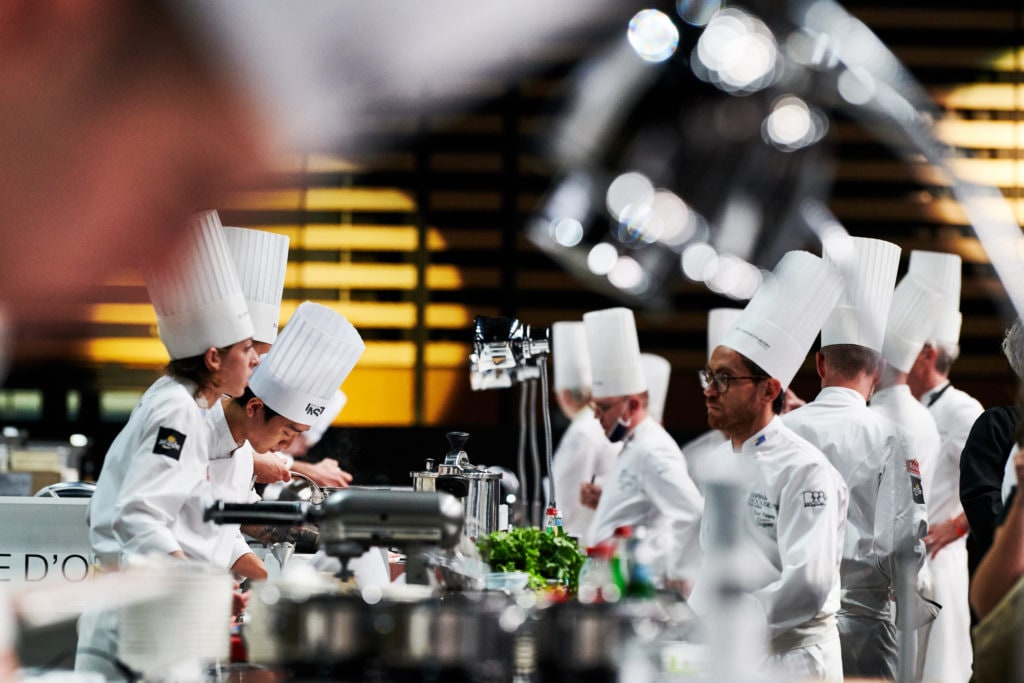
“Jiro dreams of sushi,” says Mexican chef Enrique Olvera, referring to the documentary film about Japanese sushi chef Jiro Ono. “We dream of tacos.”
Speaking from a busy street outside his restaurant Pujol in Mexico City, he is explaining how the corn used to make tortillas should be considered in the same way as the rice used in sushi. “At Pujol we have always thought of corn in the same way as most people see coffee or wine. As a crop it is a representation of the terroir and the relation between humans and the environment,” he says. “There are differences between the different varieties of corn, depending on the region they come from and the colours.”
With this serious approach to the traditional food of his country, Olvera has put New Mexican cuisine on the international map, first in Pujol, then in his New York restaurant Cosme. Since starting out many things have been said about him. Chef Alice Waters said he is on a mission to save his country’s culture, while Ferran Adriá of elBulli simply said: “There was Mexican food before Enrique Olvera and Mexican food after Enrique Olvera.”
It seems a heavy burden for one man to carry, but if Olvera feels any kind of pressure he is not saying. “I understand my work has consequences,” he says, adding that the team doesn’t have such lofty ambitions. “We feel proud of our heritage and we are trying to have beautiful restaurants and be consistent in everything we do, but that’s about it.”
Not one for making bold statements, he gets his points across subtly. When asked about the noises coming out of some of the presidential election campaigns in the US he simply points to the strength of the diverse. “I think diversity is what makes New York City strong and I think most people recognise that – people who don’t are usually not well-travelled and they haven’t eaten well,” he says.
Pujol is currently ranked 16th on the world’s 50 Best Restaurants and third on the list of Latin America’s 50 best. Last year Olvera was also handed the The Diners Club Lifetime Achievement Award; just one of many honours he has picked up in the last 15 years. In 2014 he opened Cosme in New York City, he has a chain of coffee shops in Mexico as well as two other restaurants; Manta in Los Cabos and Moxi in San Miguel de Allende. If that wasn’t enough he founded Mesamerica, a Latin American culinary conference, which he continues to oversee.
It is hard to overstate the impact he has had on the wider global restaurant scene. “When I first went to Pujol a decade ago, there was still a sense in Mexico that Europe had superior food, restaurants and cooking techniques, that the US was a step ahead and chefs seemed afraid to embrace their indigenous cuisines,” says British chef Thomasina Miers, who owns the Mexican chain Wahaca in the UK and has collaborated with Olvera. “Enrique made Mexican food contemporary and high end for the first time, celebrating Mexican ingredients and recipes from the street with humour and imagination.”
The pride in his heritage is obvious when he talks about the perception of Mexican food that still prevails around the world, with mariachis, nopales and pink flamingos. “Usually when you go to a Mexican restaurant anywhere in the world you don’t feel proud; you feel cheated. I’m standing in the street in Mexico City and there are no mariachis or nopales – the mariachis only show up for the Pujol anniversary,” he jokes.
Mexican meets New American
Olvera’s approach to his country’s cuisine is marked by the experience of going to culinary school in the US in the 1990s. At his father’s insistence he pursued a college degree and, aged 19, joined the Culinary Institute of America (CIA) in New York. “It sounded great for an adolescent who loved the idea of going to New York and exploring new places and being by myself,” he says.
Though his grandparents were in foodservice – they owned a bakery – he said his father “ran from the industry”, instead becoming an industrial engineer. He was horrified that his son wanted to become a cook because, as Olvera points out, becoming a chef then wasn’t as cool as it is today.
The experience at CIA transformed his life. At school in Mexico he was disengaged and got bad grades due to bad behaviour, but in New York he didn’t skip a day of school. “The experience in New York was really beautiful because I had felt like a weirdo in Mexico wanting to cook. In New York I became part of a community of 2,000 people just like me who found pleasure in cooking,” he says. “It was really motivating and I excelled for the first time.”
As a student he had no money to enjoy the New York dining scene on a regular basis, but he cites a meal at Eric Ripert’s Le Bernadin as a turning point. Nearly 20 years on he still remembers what he ate – soufflé of oysters, halibut with foie gras, truffles and red wine beurre blanc and pears and caramel. “I had never eaten at a restaurant that performed at such a high level and it gave me goosebumps. I realised that was what I wanted to do,” he explains.
Unlike many of his contemporaries he did not spend time in the kitchens of the famous restaurants of the time; instead he opened his own restaurant in Mexico City aged 24 straight out of college. “Even though in hindsight I wasn’t prepared – I felt like I was prepared, so I went ahead,” he says.
He had been inspired by the likes of Thomas Keller and Alice Waters of the New American cuisine movement. “They were translating popular American culture into the fine dining concept,” he says. “I knew the flavours from my childhood, but my experience meant I approached them from a different angle.”
He began travelling around his home country meeting other Mexican chefs and learned more about his culinary heritage. “You can definitely see both my experience of learning in New York and what I have learned in Mexico,” he says.
The food in Pujol today is different from the food that was served 15 years ago. Olvera had opened with a menu that he calls contemporary American with Mexican ingredients – dishes like foie gras with guava – but the first two years were a struggle. It forced a rethink of the food. “We had to think about what Mexican people most enjoyed and the conclusion was that they enjoy eating in the streets. So we started again, trying to get the flavours from the streets – that soul and power, but executed with high-quality ingredients and a lot of attention to detail,” he explains.
“I have always thought that what made Pujol special is that we sell tacos and tamales – recipes that are true and honest. I feel proud that people now recognise that tacos and tamales can be sophisticated,” he says. “We are not a contemporary restaurant using Mexican ingredients any more, but a Mexican restaurant with a contemporary style.”
The launch of Pujol was a classic start-up experience. Olvera was on his own overseeing every aspect of the restaurant, from planning the menu and selecting wines to hiring and training staff. “It was a lot to take on, but I enjoyed it and I feel the same way today. I find everything about restaurants amazing; the tableware, the music, the quality of the linen and the design of the chairs,” he says.
Fresh start
A decade after opening Pujol, investors offered him a site in New York. He didn’t feel ready at that point, but it stuck in his mind. When another offer came three years later he went for it. “I always liked the idea of opening a restaurant in New York, but then I got so busy with Pujol and almost forgot about it. By the time the second group of investors came to me I felt like a fresh start and New York gave me that,” he explains.
There are many reasons not to open a restaurant in New York, not least the high rent and famously hard-to-please dining crowd, but he welcomed the challenge. The success of Pujol and his own status in Mexico had become routine for him; he admits he was a little bored. “It was exciting to go to New York and rent a one-bedroom apartment, sleeping on a mattress on the floor and walking the streets,” he says.
Cosme opened at the end of 2014 after Olvera had spent months researching the popular restaurants of New York. He’d go along and try to figure out the elements that people liked – and what he liked. He had a clear idea of what he wanted his New York restaurant to be.
“I recognise that Pujol is a special occasion restaurant and people often visit to celebrate an anniversary or a birthday. People don’t say, ‘It’s Friday, let’s go to Pujol’. In New York I wanted a restaurant that people wanted to go to all the time.”
To achieve more of a neighbourhood restaurant vibe Cosme has an a la carte menu and there is a big bar area where guests can drop in. Like Pujol the design is very simple – an attempt, according to Olvera, to replicate the philosophy of the food by focusing on the material. “But it also shows a part of me that is much more comfortable, I’m not trying to impress anyone, not trying to demonstrate anything, but just sharing food and showing people a good time,” he says.
Cosme became an instant hit on the New York restaurant scene and reservations are hard to come by. It’s obvious that people are paying attention. “It’s too early to tell, but my hope is that Cosme proved that New Yorkers could embrace Mexican food done in a contemporary style without any of the tired old clichés,” says New York Times critic Pete Wells, who awarded Cosme three stars in his review. He says it is evident in the city already that Olvera has inspired other chefs who are keen to emulate his style. “I imagine other chefs will walk through the door that Cosme opened whether they’re cooking Mexican food or something different.”
No limits
These days Olvera splits his time evenly between Mexico and New York. “I try to wrestle my agenda the best I can but I make an effort to be in Mexico City – not just because of the restaurant but because I enjoy being here,” he says.
Travelling is major part of his career, learning and collaborating with fellow chefs around the world. “Every time we travel we bring something back. But it’s never a dish, always an idea,” he says. Though he is resolute in sticking with Mexican food, he has allowed himself to be inspired by other cuisines in Manta in Los Cabos. “Los Cabos is on the Pacific coast so we play with Peruvian and Japanese flavours – we have dishes such as tiradito and ceviche on the menu using Mexican ingredients,” he says. But don’t expect him to turn his hand to any other cuisine for now. “I enjoy those cuisines, but I know who I am and I know banana trees grow bananas. I am Mexican so I guess I should do Mexican food,” he says.
Recently, an improbable story hit the news, describing plans Olvera had to open a restaurant with two other chefs – Italian Massimo Bottura and Spanish Andoni Aduriz – in Havana, Cuba. Olvera says it is something they would like to do – they even travelled there on a research trip – but it won’t be in the very near future. “It is definitely something we look forward to doing, but fortunately we are not in a rush, we all have successful restaurants and a busy agenda, so it is something I know is going to happen, but we are not sure when,” he says.
More likely to happen first is the launch of a more casual restaurant, also in New York. It will focus on tacos and there is a chance it will also feature a separate tortilla production plant. “We did think about doing wholesale, but we are still not sure whether we should be going into a business we don’t know. We are really good at running restaurants so maybe we should just stick to that,” says Olvera. “But we realise there is potential to do something with the tortillas.”
The move would see him following in the footsteps of other high-profile chefs who have launched casual outlets, such as Momofuku chef David Chang who last year opened the chicken-focused Fuku. For Olvera it is a natural development. “I think as you mature you start decanting all your ideas and this is a long process where you go through your ideas and in the end you have one product – it could be corn or chicken or cheese,” he says. “I sometimes think I am going to end up as a cheesemonger in Oaxaca.” As farfetched as this may appear now, Enrique dreams of queso doesn’t sound an altogether unlikely title of a future chapter in Olvera’s career.
Tina Nielsen




